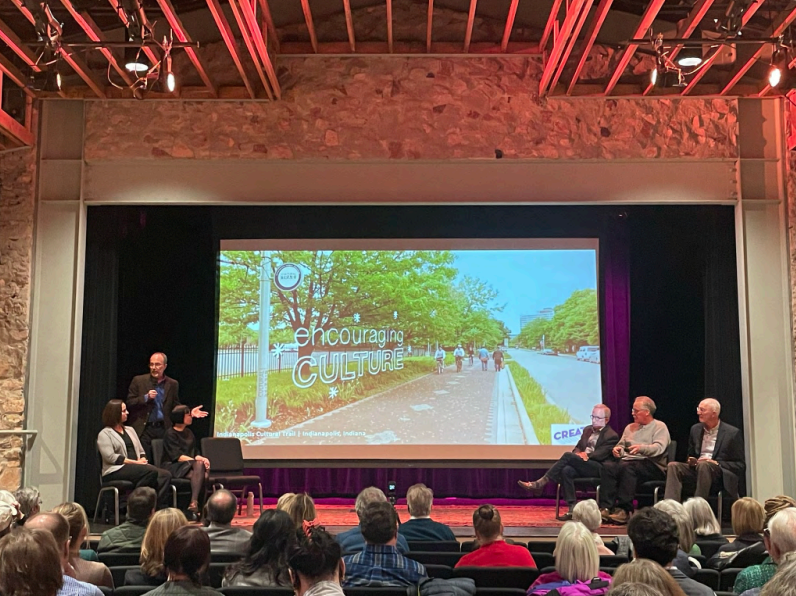Boulder ‘arts complex’ could cost $100M, take 15 years

Monday, Dec. 5, 2022
Hi, there. We’re trying to raise $10,000 this December to help keep Boulder Beat operational in 2023. Every $1 you give this month will become $4 and keep funding local, independent and 100% reader-supported local journalism. Become a paying subscriber (monthly cost matched 12X) or give a one-time gift (matched 3X) today.
Some members of the arts community might want a shiny new complex, but they would be better off using Boulder’s existing buildings.
That was the conclusion after an intensive three days of surveys and workshopping, which this week culminated in a presentation at eTownHall — itself a great example of a repurposed facility in which the arts are flourishing.
“The idea is not to go for the shiny dime,” said Jan Burton, board member of Create Boulder, a nonprofit group that lobbies for increased arts funding; Create sponsored the event. “It’s to start building something regularly starting this year.”
Big theatre is ‘least needed thing’
An arts complex built today would cost $1,000 per square foot, panelists said Thursday. At the size needed, the total cost could easily run to $100 million.
Thursday’s attendees voiced their anxieties about such a large capital project using up all the fundraising oxygen in the room. Several times, speakers mentioned not stepping on the toes of Boulder Museum of Contemporary Art, which is right now attempting to raise $13.5 million for an arts campus in North Boulder.
“We’re all sitting here in our various nonprofits: We have debt, we have challenges and operating costs,” said Kay Howe, former chair of the Museum of Boulder. How do we “work through this first stage to make the community understand this is not potential loss but potential gain?”
Adaptive reuse would also be faster. Organizers laid out a 15-year timeline for an arts center. Whereas with certain existing facilities, said Gena Buhler, of Theatre Projects, a Denver-based consulting group, “in 3-6 months you can be in a space creating.”
Quickest and easiest to procure would be two city-owned buildings: the Atrium — recently landmarked and currently home to the city’s climate initiatives department — and a senior center at 9th and Arapahoe. Further out, New Vista High School and the former Alfalfa’s at Broadway and Arapahoe may also be converted into rehearsal, meeting and office space.
“We started with the notion that Boulder might need another theater of a certain size,” said panel moderator Michael Leccese, between the Dairy Arts Center’s 250 seats and Macky Auditorium’s 2,040.
But surveys with members of the arts community revealed varying and diverse needs, from rehearsal space to offices and conference rooms.
“The big, 700-ish seat theater is kind of the least needed thing in the early going here,” said Bruce O’Donnell, principal at Starboard Realty.
‘Performing arts center PTSD’
This is not the first time a performing arts center or larger arts complex has been proposed.
“This has floated out there forever,” Boulder Museum’s Howe said. “We all think it’s never going to happen.”
“This is the third one we’ve been through,” added Marda Kim, of EcoArts Connections. “Some of us in this room have performing arts center PTSD.”
Kim also blamed the city, in part, for its lack of financial support and byzantine rules that stifle creativity. Any solution should also include a “rethinking of zoning,” she said.
“We’ve already done a whole lot of this stuff. It just hasn’t worked because the people with power don’t give us the money to do what we already do.”
Live/work spaces are exceedingly rare in Boulder, prohibited by regulations and cost. The city is trying to allow more live/work situations through updates to its rules for what types of buildings and businesses can go where. City council on Dec. 1 gave its first OK to allowing live/work spaces in industrial areas.
City funding for the arts has increased as well. Arts community requests for more money are often granted by city council; most recently last week when elected officials instructed staff to find $100,000 to help with venue affordability and artist retention.
Ongoing city funding and support will be needed no matter how the community moves forward, speakers said Thursday. Mayor Aaron Brockett and council members Bob Yates and Tara Winer attended the presentation.
Presenters stressed that a centralized facility is still possible, but that much groundwork is needed before the idea can be realized.
“All of this doesn’t mean we’re giving up on the idea of new performance venues and support for those things,” said Chris Wineman, an architect of performing arts centers. “What we’re focusing on is creating the conditions that are precursors to making that facility sustainable, busy, active and successful.
“The last thing we want to do is recommend the creation of a building that everybody says, ‘Oh crap, what do we do with this now?'”
Step 1 is identifying an organization to spearhead the effort. To create a facility by 2039, then next year “the ‘you’ needs to be formed” Buhler said. “Someone has to stand up and say, ‘I will do this,’”
— Shay Castle, @shayshinecastle
Help make the Beat better. Was there a perspective we missed, or facts we didn’t consider? Email your thoughts to boulderbeatnews@gmail.com
Want more stories like this, delivered straight to your inbox?
Uncategorized arts BMoCA Boulder Boulder Museum for Contemporary Arts city council city of Boulder Create Boulder culture Dairy Center for the Arts performing arts
Sign up for a weekly newsletter from Boulder Beat.
Uncategorized arts BMoCA Boulder Boulder Museum for Contemporary Arts city council city of Boulder Create Boulder culture Dairy Center for the Arts performing arts

